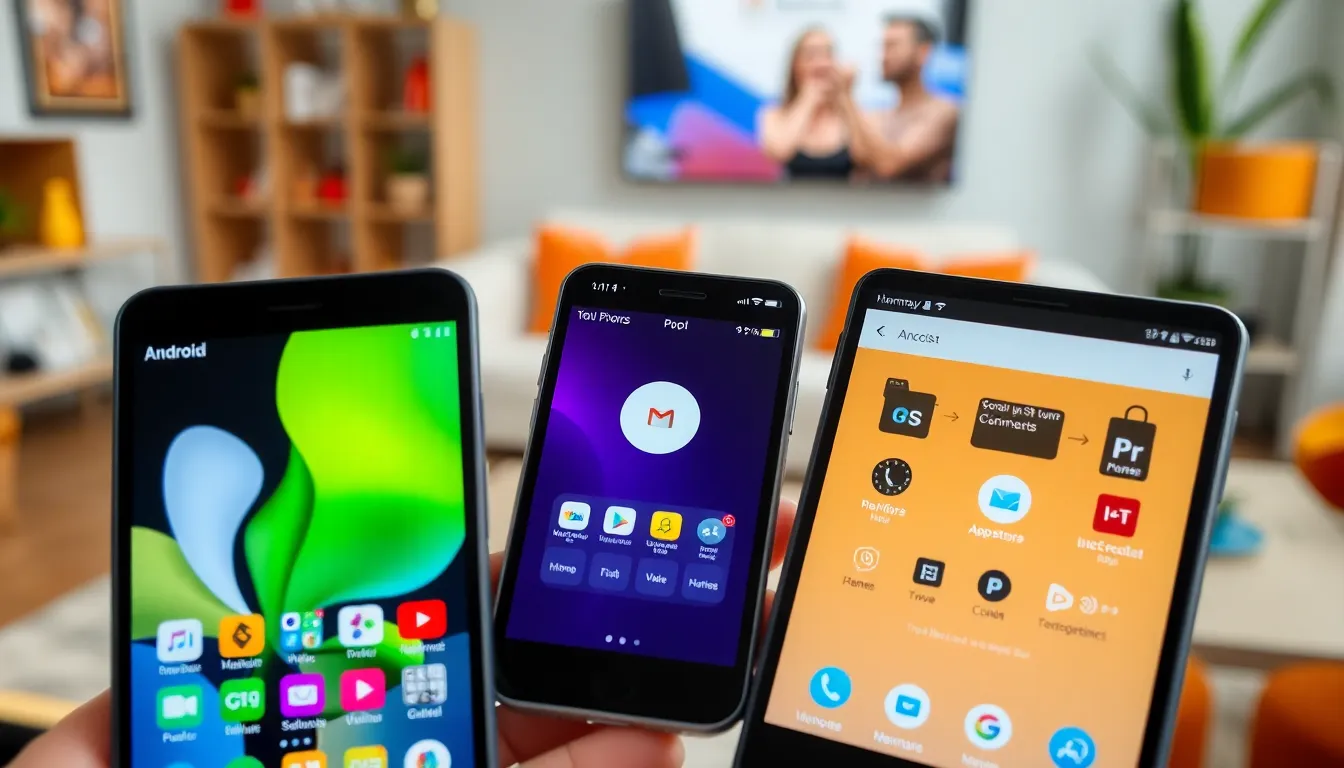In today’s digital age, phone operating systems play a crucial role in shaping user experiences. From the sleek interfaces of iOS to the customizable nature of Android, these systems dictate how users interact with their devices. Understanding the nuances of each operating system can help users make informed decisions when choosing their next smartphone.
As technology evolves, so do the features and capabilities of these operating systems. With each update, they introduce new functionalities that enhance performance and security. This article delves into the most popular phone operating systems, exploring their unique characteristics, advantages, and potential drawbacks. Whether someone is an avid tech enthusiast or a casual user, grasping the differences between these systems can lead to a more satisfying smartphone experience.
Table of Contents
ToggleOverview Of Phone Operating Systems
Phone operating systems are software platforms that enable smartphones to function effectively. These systems manage hardware resources and provide essential services for applications and user interfaces.
Definition And Purpose
Phone operating systems refer to the underlying software that runs on mobile devices. They serve the purpose of facilitating user interaction with hardware components, managing system resources, and providing a framework for app development. Prominent examples include Apple’s iOS and Google’s Android, each designed to enhance user experience through distinct features.
Key Features
- User Interface: Operating systems provide intuitive interfaces that allow users to navigate easily. iOS offers a streamlined experience, while Android emphasizes customization.
- App Ecosystem: Operating systems support application marketplaces like the App Store for iOS and Google Play for Android, providing access to millions of apps for varied user needs.
- Security: Operating systems implement security measures, like encryption and regular updates, to protect user data from threats. iOS is known for its stringent security protocols, while Android offers flexibility for third-party app installations.
- Performance Optimization: Operating systems continually evolve, improving speed and efficiency. They incorporate system updates that enhance battery life and overall device performance.
- Connectivity: Operating systems manage network connectivity, allowing users to seamlessly connect to Wi-Fi, Bluetooth, and cellular networks, ensuring consistent access to the internet and other devices.
Popular Phone Operating Systems

Phone operating systems serve as the backbone of user interaction with mobile devices. They differ significantly in features and functionality, appealing to various user preferences.
Android
Android operates as an open-source platform developed by Google. It runs on over 70% of smartphones globally. Key features include a customizable user interface, access to the Google Play Store, and extensive support for third-party applications. Android’s versatility allows manufacturers to create diverse devices with varying specifications and styles. Security measures, like regular updates and Google Play Protect, enhance user safety while maximizing performance through adaptive battery management.
iOS
iOS, Apple’s exclusive operating system, powers all iPhones and iPads. With a market share around 28%, iOS emphasizes a streamlined user experience with a focus on security and privacy. Its robust app ecosystem, featuring the App Store, hosts high-quality applications. Regular updates ensure optimal performance and introduce new features, keeping devices secure. iOS’s integration with other Apple services, like iMessage and FaceTime, provides a seamless experience for users within the Apple ecosystem.
HarmonyOS
HarmonyOS, developed by Huawei, serves as a multi-platform operating system compatible with smartphones, tablets, and IoT devices. Initially launched in 2019, HarmonyOS aims to provide a unified experience across devices. Its architecture promotes seamless device integration, with a focus on privacy and security. While still building its app ecosystem, HarmonyOS supports selected Android applications, making the transition easier for users. The system’s unique capability to connect various devices enhances the overall user experience.
Comparative Analysis
Phone operating systems differ significantly in various aspects, impacting overall user satisfaction and functionality. Understanding these differences can aid users in selecting the right platform for their needs.
User Experience
Android offers a customizable user experience, allowing users to alter home screens and choose default apps. The flexibility caters to diverse preferences, from simple interfaces to feature-rich designs. In contrast, iOS prioritizes a uniform user experience, presenting a consistent design across devices. This simplicity fosters ease of use but limits customization options, appealing to users who prefer straightforward navigation.
Security Features
Android includes a range of built-in security measures, such as Google Play Protect, which scans apps for malware. However, the open-source nature can lead to vulnerabilities, particularly with third-party applications. iOS, on the other hand, employs a closed ecosystem, enhancing security through strict app vetting and frequent updates. Apple’s focus on privacy provides users with enhanced control over data management, establishing iOS as the more secure choice for privacy-conscious individuals.
Customization Options
Customization is a hallmark of Android, granting users access to widgets, launchers, and themes. Users can tailor their experiences to meet specific needs, facilitating personalization. iOS offers limited customization, focusing more on functionality than aesthetic flexibility. While users can rearrange apps and access a few themes, the platform emphasizes uniformity over extensive personalization. This distinction influences user preference based on the importance of customization in their smartphone experience.
Future Trends In Phone Operating Systems
Phone operating systems are evolving rapidly, influenced by technological advancements and consumer demands. Future trends indicate significant improvements in performance, usability, and security.
Emerging Technologies
- Artificial Intelligence Integration: Operating systems increasingly incorporate AI for smarter voice assistants and predictive text features. AI enhances personalized user experiences through tailored app suggestions.
- Augmented Reality Capabilities: OS developers are incorporating AR functionalities, enabling immersive experiences in apps. Enhanced AR features enhance gaming and shopping applications, providing users with richer interactions.
- 5G Compatibility: Phone operating systems are prioritizing 5G integration, allowing faster data speeds and improved connectivity. Enhanced performance from 5G supports data-heavy applications like video streaming and real-time gaming.
- Foldable and Flexible Displays: Increasing support for foldable devices prompts operating systems to adapt user interfaces. New design paradigms facilitate seamless app utilization on versatile screen sizes.
- Cloud Computing Features: Enhanced cloud support in operating systems promotes storage efficiency and seamless data synchronization across devices. Features facilitate smoother backups and easy access to files from anywhere.
Market Predictions
| Year | Android Market Share (%) | iOS Market Share (%) | Emerging OS Market Share (%) |
|---|---|---|---|
| 2023 | 71 | 28 | 1 |
| 2024 | 70 | 29 | 1 |
| 2025 | 68 | 30 | 2 |
- Increased Competition: Emerging operating systems, such as HarmonyOS, are expected to capture a growing share of the market. This competition influences innovation and consumer choices.
- Customization Demand: Users are likely to gravitate toward operating systems that offer high levels of personalization. Increased customization features can elevate user satisfaction.
- Privacy and Security Focus: Continued emphasis on privacy will shape future operating system developments. Users increasingly prioritize systems with robust security measures and transparent data practices.
- Sustainability Trends: Future OS designs may incorporate eco-friendly practices, appealing to environmentally conscious consumers. Features promoting sustainability in software usage will influence user preferences.
- Cross-Platform Compatibility: Integration across various devices will become standard. Users will seek OS support that enables seamless connectivity and interoperability among smartphones, tablets, and smart home devices.
Phone operating systems play a critical role in defining user experiences and shaping the future of mobile technology. As Android, iOS, and emerging platforms like HarmonyOS continue to evolve, users can expect more personalized features, enhanced security, and seamless connectivity. The competition among these systems drives innovation and caters to diverse user preferences, ensuring that everyone can find an operating system that meets their needs.
With advancements in AI, augmented reality, and 5G, the landscape of phone operating systems is set for exciting changes. As users navigate this dynamic environment, understanding the strengths and weaknesses of each platform will empower them to make informed choices for their digital lives.










